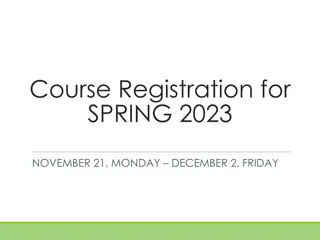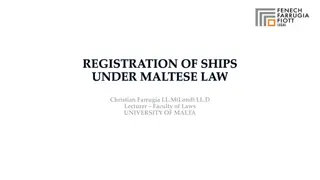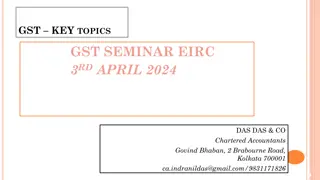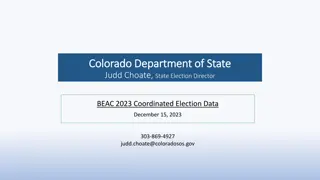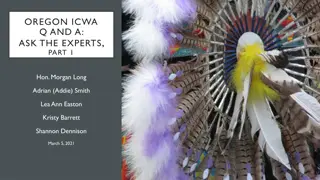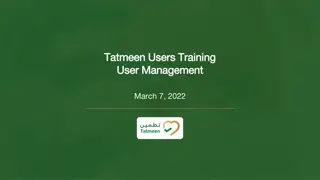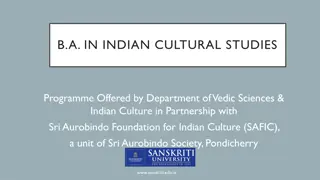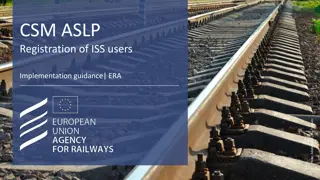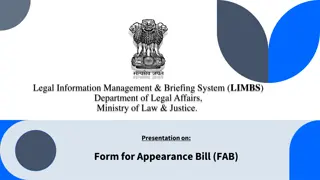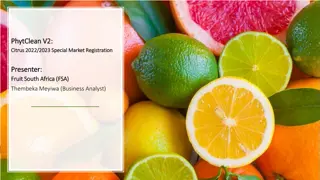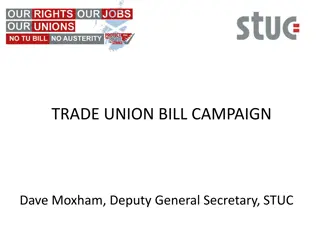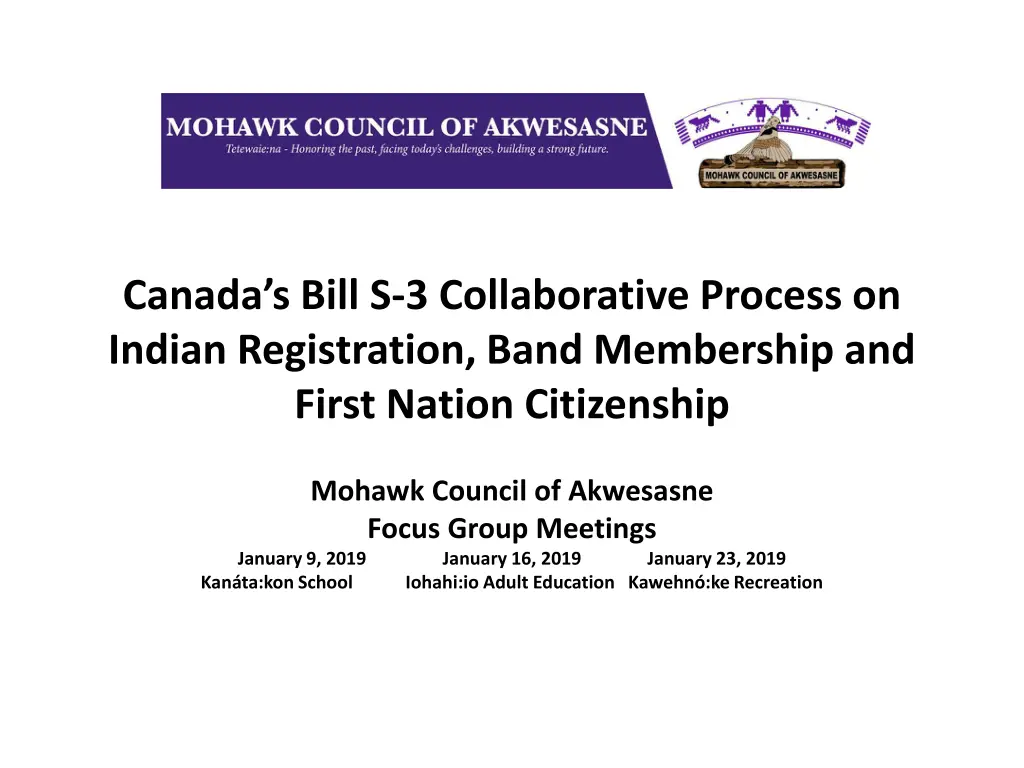
Understanding Canada's Bill S-3 Collaborative Process on Indian Registration
Explore the collaborative process on Indian registration, band membership, and First Nation citizenship by examining the focus group meetings held by the Mohawk Council of Akwesasne. Learn about the amendments introduced in response to sex-based inequities under the Indian Act and the historical context of Indigenous nation membership determinations. Discover the impact of colonialism on First Nations governance and cultural norms.
Download Presentation

Please find below an Image/Link to download the presentation.
The content on the website is provided AS IS for your information and personal use only. It may not be sold, licensed, or shared on other websites without obtaining consent from the author. If you encounter any issues during the download, it is possible that the publisher has removed the file from their server.
You are allowed to download the files provided on this website for personal or commercial use, subject to the condition that they are used lawfully. All files are the property of their respective owners.
The content on the website is provided AS IS for your information and personal use only. It may not be sold, licensed, or shared on other websites without obtaining consent from the author.
E N D
Presentation Transcript
Canadas Bill S-3 Collaborative Process on Indian Registration, Band Membership and First Nation Citizenship Mohawk Council of Akwesasne Focus Group Meetings January 9, 2019 January 16, 2019 Kan ta:kon School Iohahi:io Adult Education Kawehn :ke Recreation January 23, 2019
Opening Remarks Nia:wen / Thank you for this opportunity to talk to you about the Government of Canada announcement to eliminate sex-based inequities in Indian registration through legislative amendments to the Indian Act. This is Canada's attempt to correct their mistakes with regard to membership, status and registration under the Indian Act. This legislation is Bill S-3 which is an Act to amend the Indian Act in response to the Superior Court of Quebec decision in Descheneaux versus Canada. This Act was introduced in October 2016. January 14, 2019 2
Opening Remarks The amendments were introduced to address sex- based inequities related to differential treatment to cousins whose grandmother lost status due to marriage with a non-Indian prior to 1985 Also, to address differential treatment to women who were from of Indian fathers between 1951 and 1985 And, to address the differential treatment to minor children who were born of Indian parents or an Indian mother but lost entitlement to Indian Status because their mother married a non-Indian after their birth. January 14, 2019 3
Opening Remarks Long before European contact, First Nations had their own systems for determining the members of their nations. While each Indigenous nation established its own societal rules for determining who was part of the First Nation kinship, and community ties, were common elements. January 14, 2019 4
Opening Remarks First Nations systems of governance and cultural norms were undermined and displaced by the many actors of colonialism. The efforts of colonial administrations included legislation to determine who could be considered Indian for the purposes of residing on reserve. The definition of Indian in colonial legislation (1850-1867) was broad based, mostly sex neutral and focused on family, social and tribal ties. However in 1869 the authority to determine who was Indian shifted to government control through the Gradual Enfranchisement Actand the First Indian Act in 1876. January 14, 2019 5
Opening Remarks The early post Confederation laws established sex- based criteria, specifically rules of descent through the male lines in the definition of Indian. Particularly, the legislation removed Indian status from an Indian woman who married a non-Indian man and prevented their children and future descents from acquiring Indian Status and associated benefits. January 14, 2019 6
Opening Remarks As a result beginning in 1869 the definition of Indian was no longer based on First Nation kinship and community tied but on removing families headed by a non-Indian man from First Nation communities. This led to entire families and their descendants losing status and being forced to move away from First Nation communities. January 14, 2019 7
Understanding Membership and Registration Membership: is the status of a person recognized under a custom or law as being a member of a First Nation/community Indian Registration: registration is the status of a person registered and recognized by Canada as a Status Indian under the Indian Act. January 14, 2019 8
Section 6 of the Indian Act Persons Entitled to be Registered For all births recorded for persons born after April 17, 1985 and most Bill C-31 registrations, persons are registered either under Section 6 (1) or 6 (2) of the Indian Act. 6 (1) is an individual who has TWO parents who are registered or entitled to be registered under the Indian Act. 6 (2) is an individual who has ONE parent who is registered or entitled to be registered under the Indian Act. January 14, 2019 9
BACKGROUND ON BILL S-3 In 2011, three members of the Ab nakis of Odanak First Nation in Quebec, filed litigation in the Superior Court of Quebec challenging the Indian registration provisions under section 6 of the Indian Act as being unconstitutional and in contravention of the Charter. January 14, 2019 10
Explanation of the 1951 Cut Off On November 7, 2017, Senator Peter Harder introduced legislative changes to Bill S-3 in the Senate that will remove additional sex-based inequities that were not initially addressed. The key change will see the removal of the 1951 cut-off from the Indian Act with a delayed coming- into-force date to ensure proper consultations are completed. This amendment was supported by the Government of Canada and will effectively extend entitlement to Indian status, under subsection 6(1) of the Indian Act, to descendants of women who were removed from bands list or not considered as an Indian, prior to 1951, due to marriage going back to 1869. January 14, 2019 11
Enfranchisement Enfranchisement is a legal process for terminating a person's Indian status and conferring full Canadian citizenship. ... Two major amendments to the Indian Act, in 1951 and 1985, significantly revised those portions of the Indian Act that relate to Indianstatus, and by extension, to the process of enfranchisement. Enfranchisement gave the Government the power to say that an Indian, his wife and children under age 21 is no longer an Indian if the Minister believes that the Indian who has applied is: (a) 21 years or older; (b) able to take on the same responsibilities as other citizens; (c) will be able to look after himself and his family. January 14, 2019 12
Sex-based Inequities Include: Women who married a non-First Nations person and lost status Women and children with ONE First Nation parent Enfranchised e.g. military veterans, clergy, doctors The Sixties Scoop or the "scooping up" of 20,000 Indigenous children for placement in foster homes or adoption. Residential Schools: created for the purpose of removing 150,000 First Nation children from the influence of their culture and assimilating them into dominant Canadian culture The 1969 White Paper: proposed ending the special legal relationship between Aboriginal peoples and Canada and dismantling the Indian Act. Non-Status indigenous people such as the M tis January 14, 2019 13
Sandra Lovelace Vs Canada The Lovelace case was a challenge of law that stripped Indian woman of Indian status after marriage to non-Indian man; argued as to: Whether lost cultural benefits has continued effect; What constitutes belonging to a minority group under Article 27 of the INTERNATIONAL CONVENTION ON CIVIL AND POLITICAL RIGHTS (ICCPR); Whether interference with Article 27 of ICCPR was equal to a breach of the provision; Whether denial of the right to live on reserve was reasonable and objective; Discrimination based on gender. January 14, 2019 14
Demographic Overview: A National Perspective Alberta 128,814 British Columbia 147,124 Manitoba 159,452 New Brunswick 16,161 Newfoundland 30,637 Northwest Territories 19,444 Nova Scotia 17,397 Ontario 213,717 Prince Edward Island- 1,348 Quebec- 89,196 Saskatchewan 157,670 Yukon 9,475 As of March 2018, the total registered Indian population was 990,445 (502,953 women and 487,482 men). Of that population, it is estimated that 510,430 reside on-reserve and 480,005 live off-reserve. The Parliamentary Budget Officer s (PBO) report on the demographic impacts of delayed amendments to the Indian Act estimate that 270,000 individuals could become registered. January 14, 2019 15
PROJECTED NATIONAL DEMOGRAPHIC IMPACTS In the 2016 Census, 750,000 to 1.3 million non-registered individuals self reported as having North American Indigenous ancestry. There is significant uncertainty around determining the population impacts of the removal of the 1951 cut-off amendments as there is no data- set that can directly identify the number of individuals that could be affected. This reflects who may be entitled to, and who may be more likely to apply for Indian registration. This does not necessarily reflect how many individuals would and likely overestimates the number of individuals who would become registered. January 14, 2019 16
History of Amendments to the Indian Act Regarding Sex-based Inequities 1869 - 1876 Gradual Enfranchisement Act andfirst Indian Act Bill S-3 2017 1951 Bill C-31 1985 Bill C-3 2011 Indian Act Creation of the Indian Registrar and the Indian Register Several forms of enfranchisement introduced Reinstatement of women who married out and their children Acquiring status through marriage stopped Acquired rights protected Enfranchisement abolished Creation of ss.6(1) and 6(2) Second generation cut-off Section 10 and section 11 174,000 registered Additional generation descendants of women who were married non-Indian men became entitled Immediate changes: In force on December 22, 2017 Descheneaux case: Cousins Issue Siblings Issue Omitted Minors Issue Unknown or Unstated Parentage From band list to central register and management by the federal government Patrilineal rules of descent introduced Introduction of the 1951 cut-off Sex-based discrimination 37,000 registered Delayed changes: Removal of the 1951 cut-off The term Indian was defined Other Obligations: Consultation Report to Parliament - June 12, 2019 January 14, 2019 17
Financial Impacts Status Indians living on or off-reserve are eligible for non-insured health benefits, as well as postsecondary assistance. For status Indians living on- reserve, the federal government funds housing, elementary and secondary education, health services and social assistance. Between 1985-1986 and 1989-1990 the number of Bill C-31 students rose from 446 (4% of the program) to 3,562 (19% of the program) with an increase in expenditures on Bill C-31 students increasing from $.9 million to $27.9 million. In 1989-1990 $41 million in Bill C-31 supplements funded 1,353 new units representing 30% of total on reserve housing expenditures. Costs for non-insured health benefits for Bill C-31 registrants rose from $2.5 million in 1985-86 to $39 million in 1989-1990 representing 15% of the total expenditures for status Indians under the program. January 14, 2019 18
The Descheneaux decision and the federal response The Descheneaux Decision and the Federal Response Descheneaux In August 2015 the Superior Court of Quebec declared that key provisions of the Indian Act unjustifiably violated equality rights under the Charter by perpetuating sex-based inequities in eligibility for Indian registration between descendants of the male and female lines and order Canada to amend the Indian Act. It also brought to light the long-standing and unaddressed broader issues relating to Indian registration, band membership and First Nation citizenship. Canada s Two-stage Response: 1. Legislative Changes: amendments to the Indian Act to address sex-based inequities in registration in direct response to Descheneaux (Bill S-3) to fix the cousins and siblings issues 2. Collaborative Process on Indian registration, band membership and First Nation citizenship: comprehensive consultations on broader issues with a view to future reform. https://www.canlii.org/en/qc/qccs/doc/2015/2015qccs3555/2015qccs3555.html?resultIndex=9 January 14, 2019 19
Collaborative Process on Indian Registration, Band Membership and First Nation Citizenship Co-design The Government launched the Collaborative Process with First Nations and other Indigenous groups to consult on the broader related issues of Indian registration, Band membership and First Nation citizenship to identify areas for future reform. It builds on the 2011-2012 Exploratory Process on Indian Registration, Band Membership and Citizenship. CREATION OF INDIGENOUS ADVISORY PANEL (May 24, 2018) Provides advice and guidance through the Collaborative Process - Launch of Consultations June 12, 2018 ANNOUNCEMENT OF CONSULTATION APPROACH Formal announcement, MSR appointment, Call for funding proposals Information Sharing INFORMATION SESSIONS (June to September, 2018) Information on current issues of Indian registration and consultation process (Information presentation / Fact sheets) COMMUNITY SESSIONS Info Gathering (Sept 2018-March 2019) Sharing of Input Gathered Throughout the Process REGIONAL EVENTS MSR-led events held across the country to offer a discussion-forum for issues, share perspectives, and provide consultation input ONLINE CONSULTATION Online survey available to everyone . Offers confidentiality Managed by specialized firm Co-design Input was collected for the Collaborative Process Oct 31, 2017 Mar 31, 2018 EXPERT PANEL(S) Indigenous/non-Indigenous legal and scholarly expert panel discussions may be undertaken as part of Regional Events or separate May 10, 2018 Report to Parliament on the Design of a Collaborative Process OTHER GOVERNMENT / PROVINCES TERRITORIES Seek input from impacted federal departments and provinces/territories Will be undertaken late in the process extending past June 2019 Analysis ANALYSIS AND RECOMMENDATIONS Consultation input from MSR, community sessions, survey reviewed, analyzed and recommendations developed on 1951 cut-off implementation and future legislative reform REPORT TO PARLIAMENT - June 2019 Will address recommendations on: 1951 cut-off implementation, Changes to broader Issues and future legislative reform for control by First Nations January 14, 2019 20
Consultation Streams What We Should Discuss The Collaborative Process will address the following streams: 1. Implementation of the removal of the 1951 cut-off Implementation of the delayed coming-into-force of the removal of the 1951 cut-off, how best to implement the changes to ensure adequate resources are provided and any unintended consequences are mitigated. 2. Remaining inequities related to registration and membership under the Indian Act Adoption, the second generation cut-off, unknown/unstated paternity, enfranchisement, deregistration, children of same sex parents, categories in Indian registration, cross- border issues and non-cisgender identities as it relates to Indian registration and band membership. 3. First Nations exclusive responsibility for determining membership /citizenship (moving beyond the Indian Act) Federal versus First Nation role and the development of options for First Nations to take exclusive responsibility for the determination of the identity of their members or citizens. January 14, 2019 21
Stream 1 The removal of the 1951 cut-off from the Indian Act Discussions around the implementation of the delayed coming-into-force clauses in Bill S-3 relating to the removal of the 1951 cut-off. First Nations will be consulted on how best to implement the changes, to identify what resources are required and to ensure any unintended consequences are mitigated. 1) How will the removal of the 1951 cut-off impact you and our community? (e.g.: environmental, economic, land, services, cultural, migration back to reserve, governance, upcoming ratification, demographic impact, membership ) 2) How can the Government of Canada assist in addressing the impacts of the removal of the 1951 cut-off? (e.g. capacity, additional resources, timeline, process ) January 14, 2019 22
Stream 2 - Remaining inequities related to registration and membership under the Indian Act These issues were articulated in Bill S-3 and enhanced by the input. This includes issues such as, but not limited to: Adoption Second-generation cut-off Unknown/unstated paternity Enfranchisement Categories in Indian registration Cross-border issues Children of same sex parents Non-cisgender identities as it relates to Indian Registration and band membership 1) Are there other inequities that need to be discussed (e.g. cross-border issues)? What are they? 2) What would you recommend for the next steps going forward (e.g. elimination of Section 6)? January 14, 2019 23
Stream 3 - First Nations exclusive responsibility for determining membership (moving beyond the Indian Act) 1) Should Akwesasne, as well as other First Nations in Canada take on the exclusive responsibility for determining membership? Why or why not? 2) What do you see as the federal role in this process (in terms of the Indian Register and determination of Indian Status)? 3) What would you recommend as the next steps going forward? January 14, 2019 24
Community Engagement CKON Radio January 2, 2019, Time 9:30 10:30 am January 28, 2019, Time 9:30 10:30 am Focus Groups January 9, 2019 Kan ta:kon , Kan ta:kon School 6-9pm January 16, 2019 Tsi Snaihne, Iohahi:io 6-9 pm January 23, 2019 Kawehn :ke, Kawehn :ke Recreation, 6-9 pm Community Engagement Session February 6, 2019, Akwesasne Mohawk Casino, 9 am to 4 pm MCA Report to the Government of Canada March 15, 2019 January 14, 2019 25

